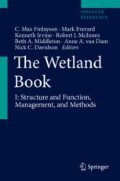Abstract
The Tonle Sap Lake in Cambodia is considered the “heart” of the Mekong River Basin, helping to pulse the flood waters in and out during the high and low flood seasons and saving large areas in the Mekong Region from flooding and drought. The inflow and outflow of the water between the Mekong River and the Tonle Sap Lake enriches catchment biodiversity and fisheries; the lake itself also an important location for biodiversity and fish. The Tonle Sap Great Lake is connected to the Mekong River through the 100 km long Tonle Sap River, close to 60% of its water originating from the Mekong with the rest coming from local tributaries and rainfall over the lake. The Great Lake covers an area of 250,000–300,000 ha in the dry season and 1.0–1.3 million ha in the wet season. The Tonle Sap Great Lake and floodplain is characterized by high fishery and agricultural productivity, with close to 300 fish species found in the Lake. The Tonle Sap fisheries account for about 60% of the national fish catch. Hydrological fluctuation and dispersed resources around the lake shape the ways in which people settle on the lake geographically, ecologically, and socially with a human population in the Tonle Sap Basin of more than four million.
References
Asian Development Bank (ADB), Food and Agriculture Organization (FAO), Fisheries Administration (DoF). General fisheries plan for the management and protection of the Tonle Sap, Tonle Sap environmental management project. Phnom Penh: Fisheries Administration; 2003.
Baran E. Cambodian inland fisheries: facts, figures and context. Phnom Penh: WorldFish Center; 2005. 44pp.
Baran E, Starr P, Kura Y. Influence of built structures on Tonle Sap fisheries. Phnom Penh: Cambodia National Mekong Committee/WorldFish Center; 2007. 44pp.
CNMC (Cambodia National Mekong Committee and WorldFish Center. Infrastructure and Tonle Sap fisheries – how to balance infrastructure development and fisheries livelihoods? Phnom Penh: Cambodia National Mekong Committee/WorldFish Center; 2007. 12pp.
FAO (Food and Agriculture Organization of the United Nations). National medium-term priority framework. Bangkok: FAO; 2011.
FiA (Fisheries Administration). Fishing for the future. The strategic planning framework for fisheries (2010–2019). Phnom Penh: Fisheries Administration/Ministry of Agriculture, Forestry and Fisheries; 2009. 58pp.
Joffre O. Aquaculture production in Cambodia. Report for the ACIAR funded project “Assessing economic and welfare values of fish in the Lower Mekong Basin”. Phnom Penh: WorldFish Center; 2012. 14pp.
Johnstone G, Puskur R, DeClerck F, Kosla M, Oeur I, Mak S, Pech B, Seak S, Chan S, Hak S, Lov S, Suon S, Proum K, Rest S. Tonle Sap scoping report. CGIAR Research Program on Aquatic Agricultural Systems. Penang. Project Report. AAS-2013-28; 2013.
Kurien J, Baran E, Nam S. Factors that drive Cambodia’s inland fish catch: what role can community fisheries play? Phnom Penh: WorldFish Center/Inland Fisheries Research and Development Institute; 2006. 12pp.
Mekong River Commission (MRC). State of the Basin Report. Phnom Penh: Mekong River Commission Secretariat (MRCS); 2003.
Nasielski J, Baran E, Tress J. Role of fish in rural livelihoods: methodology for a welfare-based assessment. Communication at the 10th Asian Fisheries and Aquaculture Forum, 30 April–4 May 2013, Yeosu; 2013.
Navy H, Leng S, Chuenpagdee R. Socioeconomics and livelihood values of the Tonle Sap Lake fisheries. Phnom Penh: Inland Fisheries Research and Development Institute/Fisheries Administration/Ministry of Agriculture, Forestry and Fisheries; 2006. 24pp.
Nikula J. The Lake and its People. MSc Thesis, Helsinki University of Technology. 2004.
NIS (National Institute of Statistics). General population census of Cambodia 2008: provisional population totals. Phnom Penh: NIS/Ministry of Planning; 2008. 37pp.
Ratner B. Policy review: community management by Deccree? Lessons from Cambodia’s fisheries reform. J Soc Nat Resour. 2006;19:79–86.
Save Cambodia’s Wildlife. The Atlas of Cambodia: national poverty and environment maps. Phnom Penh: Save Cambodia’s Wildlife/DANIDA; 2006. 141pp.
Sithirith M. Political geography of the Tonle Sap: power, space and resources. PhD Dissertation, National University of Singapore, Singapore. 2011.
Sithirith M, Grundy-Warr C. Floating lives of the Tonle Sap. Chiang Mai: Regional Center for Social Science and Sustainable Development/Chiang Mai University; 2013.
Somony T, Schmidt U. Aquatic resource management: Tonle Sap Great Lake, Cambodia. Phnom Penh: Department of Fisheries; 2004.
Tonle Sap Authority. http://www.tonlesap.gov.kh (2013). Accessed 15 Sept 2014.
Wright G, Moffat D, Wager J. Establishment of the Tonle Sap Basin management organization: Tonle Sap Basin profile. Phnom Penh: Asian Development Bank/Cambodian National Mekong Committee (CNMC); 2004.
Author information
Authors and Affiliations
Corresponding authors
Editor information
Editors and Affiliations
Rights and permissions
Copyright information
© 2018 Springer Science+Business Media B.V., part of Springer Nature
About this entry
Cite this entry
Johnstone, G., Sithirith, M. (2018). Tonle Sap: Fisheries Management Case Study. In: Finlayson, C.M., et al. The Wetland Book. Springer, Dordrecht. https://doi.org/10.1007/978-90-481-9659-3_202
Download citation
DOI: https://doi.org/10.1007/978-90-481-9659-3_202
Published:
Publisher Name: Springer, Dordrecht
Print ISBN: 978-90-481-3493-9
Online ISBN: 978-90-481-9659-3
eBook Packages: Biomedical and Life SciencesReference Module Biomedical and Life Sciences

